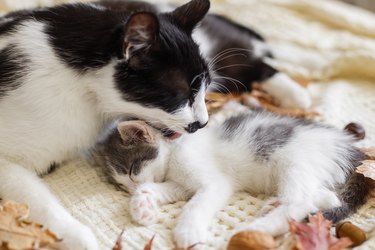There are other concerns as well. It’s crucial that your partner supports the idea of breeding and raising cats if you have one. When exhibiting your cats, it’s common for someone to remain behind and take care of the remaining cats in the space (particularly if you’re showing a new litter at the same time). Your partner may not find it enjoyable to clean litter boxes, vacuum, scrub, or bathe cats, which can result in problems that are much more complicated than just the cats. Additionally, if you have kids, you need to think about how much time your kids will need to spend taking care of your cats. Many families involve their kids in cat care, which can teach them responsibility and animal respect. It also gives the kids a fun pastime that many grow to love. Older kids can work as ring stewards in the show hall, cleaning cat cages before and after competitions, and earning extra cash for whatever they might want to buy. But, if your kids don’t want to interact with the cats, they could cause more trouble than enjoyment.
The emotional cost of raising any animal is the last point to think about. Breeding animals is heartbreaking—losses are inevitable and sometimes unavoidable. Will you be able to accept the possibility of kittens dying? Will your heart be strong enough to mourn the loss of a kitten that you held in your hands and watched it take its last gasp and then be able to face the next kitten, the next possible loss? Sometimes you make a mistake that results in losses that could have been prevented. It is inevitable for novice breeders to commit errors that will endanger the lives of the kittens they have bred. This is a harsh, painful reality. In addition to losing kittens, you also have to say goodbye to the ones you raised when it’s time for them to find new homes. It goes without saying that you will form an emotional bond with a kitten you have raised from birth, and parting with them is harder than you initially anticipated. New breeders frequently make the mistake of keeping too many kittens because they soon become “over-catted” and overwhelmed by the amount of work required to care for so many cats. The third area that novice breeders typically run into issues with is the breeding cats themselves, even if you can handle the losses and release the kittens. Again, this can lead to a situation where the breeder is overwhelmed by the number of cats they have to care for. They have a tendency to keep them too long and then end up with a “top heavy” number of cats, meaning they have more cats that are not breeding than are.
Disclaimer: Before starting any treatment, consult your veterinarian about any medical advice provided in this article. The author’s thoughts and opinions are presented in this article, which may not accurately represent the official policies or stances of the Persian Breed Council or the Cat Fanciers Association.
There are a few crucial things to think about before you even begin your first cat breeding search. First, especially in light the shaky economy, is finances. A nice show-quality Persian cat can cost anywhere from $1500 to over $3500, depending on factors like pedigree, titles, and other factors. ) This is for a single cat. A basic program needs 1 male and 2-3 females. Most aspiring breeders believe they will only need one female and will obtain stud service for her, but you will soon discover that the cat fancy does not typically provide stud service. The homes you would want your female to be bred in are usually not those breeders who do allow stud service. Additionally, there is the cost of care, upkeep, and showing. Cats that are breeding should be fed premium foods, which typically run from $1 to $5 per pound. Additionally, breeding cats fare better when fed a diet rich in raw meat in addition to dry “kibble” food. The cost of a good cut of meat can range from $1 to $5 per pound, depending on availability. In addition, bowls, litter, litter pans, and medical supplies need to be taken into account. Vet visits are necessary for everything from routine checkups to the inevitable illness of a new cat. It is advisable to have some medications on hand in order to promptly address any minor issues that may arise. If there are no serious health issues, like a c-section (which can easily cost $2000), the average monthly maintenance cost for a single Persian cat is $50. It is necessary to budget an extra $200 per show week (minimum) if the cat is being shown. (The majority of shows need travel, and many will need hotel stays for the night.) This all adds up!).
What you will do with the kittens you produce will be your next task. It’s possible that your friends from before you bred the cat have changed. They may determine that now is simply not the right time for them to have a kitten. Additionally, while you were busy getting a breeding cat and raising the litter, they might have found a cat somewhere else. (The reason most breeders dislike maintaining waiting lists is that people who say they will wait rarely actually do.) It’s possible that a kitten with “special” needs won’t make an “easy” pet, in which case you’ll have to keep the kitten yourself.
Know the breed standard
Before you consider breeding your Persian cat, familiarize yourself with the breed standard for Persian cats and make sure your cat is a good example of it. No matter how adorable your pet may be, reproducing poor traits in the breed can result in cats that no one wants to buy, and they could eventually wind up in the animal shelter system.



Video of the Day
Your cat may be precious to you because of totally adorable features like crossed eyes or a kinked coat, but those are just two of many undesirable breed traits that are major disqualifiers in the show ring. Examine the breed standard to see if your cat possesses any traits that would disqualify it.
You most likely paid several thousand dollars for your cat from a reputable breeder if she is of breeding quality. Breeders frequently sell Persian cats suitable for pets, but at a lower price than breeding cats.

You wont find high-quality Persians at pet stores, on Craigslist, or at the local flea market. The best bet for buying a breedable Persian is to look for a registered cattery through the Cat Fanciers Associations Find a Breeder page.



Visit the breeder’s website to see if there are any genetic health concerns that the breeder tests for and offers health guarantees for. Examine the parents’ lineage and observe if the majority of the previous four generations are CH (champion), GC (grand champion), RW (regional winner), or NW (national winner).
Remember that a cat with the title of champion simply has to have attended one show and not been disqualified in six rings. Grand champion cats are those that have been judged to be superior to at least 200 other cats. Regional winner and national winner titles are even more desirable. When purchasing a cat for breeding, look for more GC, RW, and NW designations than CH in the cat’s last four ancestral generations.
If youre looking to start a Persian cattery, youd want to buy two to three females and one male. However, if youre looking to breed a quality female you already have, you might be able to find a stud. Finding a breeding-quality stud isnt always simple, as most registered catteries dont offer stud-for-hire services.
Persian cat maturity age is another consideration. Male Persians don’t breed until they are between 20 and 24 months old, while females can start breeding at 10 months. If you would rather purchase your own stud, you might want to look into getting a cattery’s proven breeding male.
Keep in mind that both male and female cats will spray urine to mark their territory, but unneutered male cats — known as “toms” — are the most likely to do so. Some cat breeders keep their breeding male in an outdoor house with an enclosure to contain the pungent smell and bring the breeding females — also known as “queens” — to the tom when breeding is desired.
Know how to show
To confirm that you are breeding Persian cats according to the standards, you must display your parent cats. The first step for novice breeders should be to purchase and enter a neutered cat in a premiership class. Through this, you can become fully immersed in the world of cat showing and determine whether the grooming, training, and other aspects of the experience are right for you.
You could also display your existing pedigreed female cat. Allowing her to compete in the ring will help determine whether she has the qualities desired by Persian cat enthusiasts looking to purchase progeny.
Being surrounded by knowledgeable cattery owners who can offer you advice on Persian cat breeding makes the show ring a great resource.
For a number of reasons, each breeding cat should be housed individually in a spacious room or cage that is at least five feet long and has a shelf that she can jump onto.
- Organizing your female cat’s breeding schedule: Having cats living together will prevent you from knowing when your cat became pregnant or when her period is due.
- Guarding the queens and kittens: Toms occasionally decide they must mate with a kitten, which can cause a spinal injury or even death.
- Protecting your female: Letting a tom breed her or getting pregnant before she is fully developed at 10 to 12 months old can be harmful to her health, even though she may cycle into heat as early as 5 months.
- Allowing a queen to heal: Rebreeding can occur as soon as a few weeks after childbirth, which physically exhausts queens.
- Health considerations: Men should have their urine output checked daily because they are more likely to develop bladder stones, which can obstruct the urethra. It won’t be evident to you if they’re not urinating unless they use their own litter box.
- Pregnant women should be confined during the final two weeks of their pregnancy to protect them from misjudging a jump that could cause harm or miscarriage.
- Providing security: When new mothers are anxious, they frequently shuffle their kits around, sometimes forgetting to place one behind a bed or under a couch. Providing mom with a cage can make her feel safe and guarded.
FAQ
Can you breed Persian cats?
What age can I breed my Persian cat?
How many babies does Persian cat give?
How do you start breeding cats?